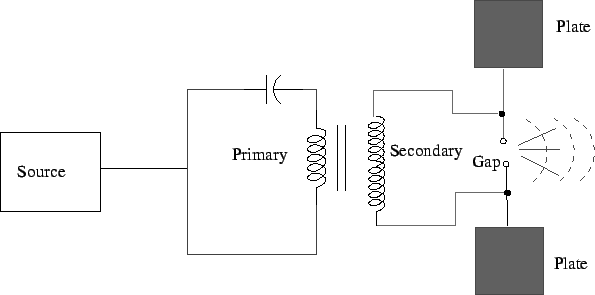SKEDSOFT
Generation of Electromagnetic Waves: We have looked for solutions to Maxwell's equations in free space which does not have any charge or current source. In the presence of sources, the solutions become complicated. If ![]() = constant, i.e. if
= constant, i.e. if ![]() , we only have a steady electric field. If
, we only have a steady electric field. If ![]() varies uniformly with time, we have steady currents which gives us both a steady electric field as well as a magnetic field. Clearly, time varying electric and magnetic fields may be generated if the current varies with time, i.e., if the charges accelerate. Hertz confirmed the existence of electromagnetic waves in 1888 using these principles. A schematic diagram of Hertz's set up is shown in the figure.
varies uniformly with time, we have steady currents which gives us both a steady electric field as well as a magnetic field. Clearly, time varying electric and magnetic fields may be generated if the current varies with time, i.e., if the charges accelerate. Hertz confirmed the existence of electromagnetic waves in 1888 using these principles. A schematic diagram of Hertz's set up is shown in the figure.

The radiation will be appreciable only if the amplitude of oscillation of charge is comparable to the wavelength of radiation that it emits. This rules out mechanical vibration, for assuming a vibrational frequency of 1000 cycles per second, the wavelength work out to be 300 km. Hertz, therefore, made the oscillating charges vibrate with a very high frequency. The apparatus consists of two brass plates connected to the terminals of a secondary of a transformer. The primary consists of an LC oscillator circuit, which establishes charge oscillations at a frequency of ![]() . As the primary circuit oscillates, oscillations are set up in the secondary circuit. As a result, rapidly varying alternating potential difference is developed across the gap and electromagnetic waves are generated. Hertz was able to produce waves having wavelength of 6m. It was soon realized that irrespective of their wavelength, all electromagnetic waves travel through empty space with the same speed, viz., the speed of light.
. As the primary circuit oscillates, oscillations are set up in the secondary circuit. As a result, rapidly varying alternating potential difference is developed across the gap and electromagnetic waves are generated. Hertz was able to produce waves having wavelength of 6m. It was soon realized that irrespective of their wavelength, all electromagnetic waves travel through empty space with the same speed, viz., the speed of light.

Depending on their wavelength range, electromagnetic waves are given different names. The figure shows the electromagnetic spectrum. What is known as visible light is the narrow band of wavelength from 400 nm (blue) to 700 nm (red). To its either side are the infrared from 700 nm to 0.3 mm and the ultraviolet from 30 nm to 400 nm. Microwaves have longer wavelength than the infrared (0.3 mm to 300 mm) and the radio waves have wavelengths longer than 300 mm. The television broadcast takes place in a small range at the end of the microwave spectrum. Those with wavelengths shorter than ultraviolet are generally called rays . Prominent among them are x-rays with wavelengths 0.03 nm t0 30 nm and ![]() -rays with wavelengths shorter than 0.03 nm.
-rays with wavelengths shorter than 0.03 nm.